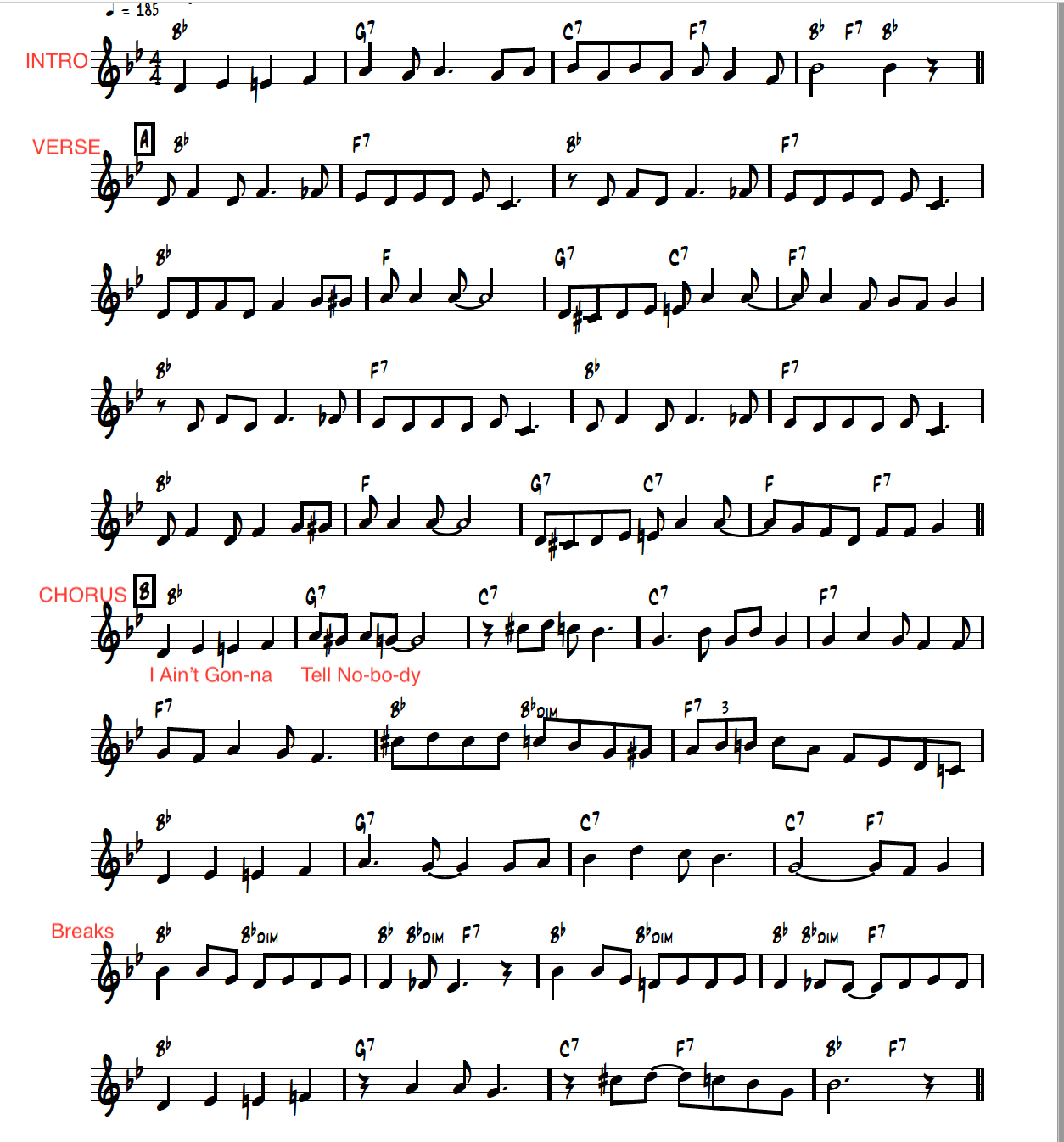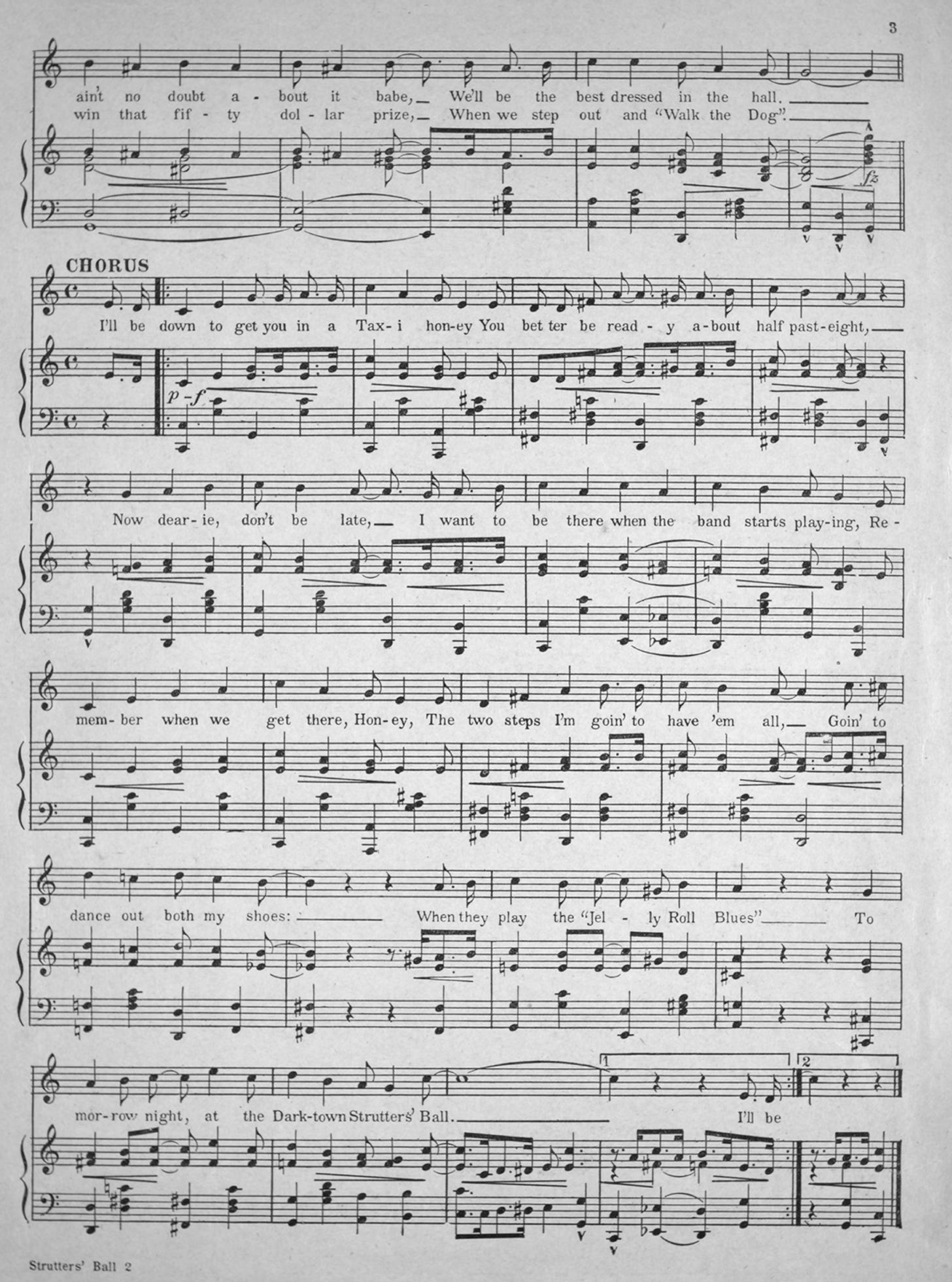(Paying Subscribers, a rare photo of the Oliver band from 1924 is at the very bottom. THANK YOU!)
In Part 1, you read quite a bit of background about the band, and you listened to “I Ain’t Gonna Tell Nobody.” Now, let’s go back and listen again (to a different remastering), while I point out a number of details.
For reference, let’s use a “performer’s leadsheet” of the song prepared by Scott Sproxton, based near Calgary, in Alberta, Canada. His site, Simply Early Jazz, offers a free downloadable 750-page book of leadsheets of early jazz tunes, including many songs that are not found anywhere else! The page below is from that book. He also offers scores and parts of many early jazz pieces, at very low prices. I’ve put a sample score page below. His leadsheets and scores are of course based closely on the recordings, but they have been adapted to make them easily performable. That is, they are not meant to be exact transcriptions. For example, the single-line melody leadsheet of “Ain’t Gonna..” incorporates some of the clarinet lines as well as the lead cornet parts. Also, Scott placed it in the key of Bb, but the recording is in C.
This sheet is a very helpful guide for following the recording. Here it is, with my annotations in red.
First there’s a four-bar introduction, then the 16-measure verse begins on the second line of the music. In old songs and Broadway shows, the verse usually sets up the story, with words like “The other night, my baby up and left me…,” or “I’ve met many people, but nobody like you,” etc. This leads into the chorus—the body of the song, the main melody, often repeated with different lyrics. As I mentioned last time, this song was not published, so we don’t know the words, but leading into where I’ve marked “Chorus” at letter B, you can almost hear them play, “Sooo…, I Ain’t Gonna Tell Nobody.” In this case the chorus is 20 bars long. (Musicians today are more familiar with the 32-bar choruses of “standard” songs, and they almost never perform the verse. But cabaret singers do.)
If you’re familiar with the very popular (and now very politically incorrect) song, “Darktown Strutters’ Ball,” by another Black songwriter, Shelton Brooks, the form is very similar. Here is the original 1917 sheet music:
There’s an introduction—in this case, 8 bars, plus a vamp that can be repeated until the singer is ready. The verse is, once again, 16 measures, and in this case it has two sets of lyrics, so that it can be repeated if desired. (The verse does not have a repeat sign, but the chorus does.) On the second line of the second page, the “Chorus” is clearly marked, and it’s 20 measures long, as in “Ain’t Gonna..” By the way, the publisher, Will Rossiter, may have suggested including the reference to Morton’s “Jelly Roll Blues”—Will had published it in 1915. (It would first be recorded in the early 1920s.)
Back to “Ain’t Gonna..,” you may be surprised at 1:15 to hear the band play the verse again. This was actually very common in instrumental recordings of the 1920s. The thinking was that, once he verse was over, playing the chorus 4, 5, or 6 times in a row would be too boring for the listener. So the verse was often inserted again. Another approach, not used here, was to play the chorus at the beginning, and then the verse, then back to the chorus—another way to avoid monotony.
OK, so on the Oliver recording, at 0:25 you’ll hear the instruments play the chorus that starts with “I Ain’t Gonna Tell Nobody.” Each time that theme is played, something different happens on the second line from the bottom ofd the leadsheet above, where I have marked “Breaks.” And after each “break” the band drives forward into the next chorus with increasing excitement and intensity. The overall layout of the recording is:
Intro/Verse/Chorus 1/Chorus 2/Verse/Chorus 3/Chorus 4/Chorus 5/Chorus 6/Tag.
Here are some moments to listen for—especially notice 2:25, where Oliver plays first, and Louis joins in, just as Louis described in Part One!
LISTENING NOTES:
You can hear the drummer’s cymbal at 0:05 and 1:10.
0:06—The verse.
0:25—First chorus of “I Ain’t Gonna Tell Nobody.”
0:40—They play right through the “break” line.
0:50—They go on to a second chorus.
1:04—At the “break” line, the band does some pre-arranged stops, that is, “breaks” in the rhythm.
1:15—Back to the verse.
1:33—The chorus, for the third time. Notice the very lively trombone playing.
148—The cornets play through the break—one in particular, Louis I think, plays eighth notes, then climbs up to a high E and sails through to the next chorus.
2:00—Fourth chorus. There’s a tremendous amount of activity now, from everyone—clarinet, trombone, bass sax, piano—and the drums and banjo are creatively chopping up the rhythm.
2:09—Both cornets play a blue note, harmonized in thirds, then at the break they both play it again, twice. One does a growling sound at 2:18—that’s Oliver, I think.
2:25—Fifth chorus. The group intensity continues. At 2:40, at the break, we get a moment like what Armstrong described on TV in Part One! First we hear Oliver play a line solo, by himself, and then Louis joins in for the second time! One of them holds an Eb blue note into the next chorus.
2:50—Chorus 6. One senses that this band could maintain this intensity longer, and I would assume they did so in performance, but for the recording they had to wrap it up. So this time, at the break line (3:04), the trombonist plays a rehearsed slide twice, and they finish up, adding a 2-measure repeat. That’s called a “tag” because it’s “tagged” on to the ending.
Let’s listen to a different remastering this time—by the late John R. T. Davies, a well-loved specialist in early jazz sound restoration. (His version plays just three seconds slower than Sager’s version, but is still in the key of C.) If you wish, you might compare how this version sounds with the one on the previous post. After you’ve followed through once with my notes, I suggest listening again with your eyes closed, so that you can really focus:
Before we go, here is a sample score page from Simply Early Jazz—representing the first 7 seconds of the recording. (Parts are included with every score.)
I hope this band is “speaking” to you the way it speaks to me. There is more to come!
(Paying Subscribers, please scroll down.)
All the best,
Lewis
Keep reading with a 7-day free trial
Subscribe to Playback with Lewis Porter! to keep reading this post and get 7 days of free access to the full post archives.






